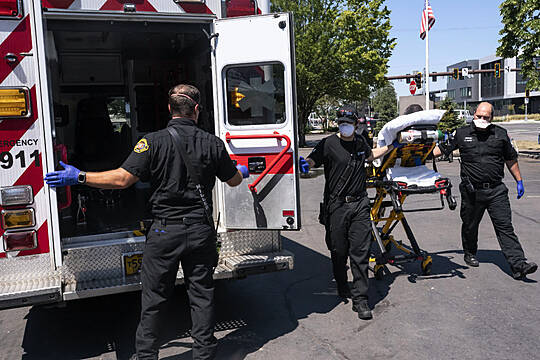Hundreds of people are feared to have died during record-breaking temperatures in the Pacific Northwest and western Canada.
Officials have set up cooling centres, distributed water to the homeless and took other steps as the mercury climbed as high as 46C in cities such as Seattle and Portland.
The death toll in the state of Oregon reached 79. In Canada, British Columbia’s chief coroner Lisa Lapointe said there were reports of at least 486 “sudden and unexpected deaths” between last Friday and Wednesday.

In Oregon’s Multnomah County, the oldest person to die was 97 and the youngest 44.
Authorities in the county turned nine air-conditioned county libraries into cooling centres, where 7,600 people cooled off between Friday and Monday. Officials acknowledge this is not enough, and say there are lessons to be learned.
Washington state authorities have linked more than 20 deaths to the heat, but officials said that number is likely to rise.
Oregon’s office of emergency management director Andrew Phelps said: “Learning of the tragic loss of life as a result of the recent heat wave is heartbreaking. As an emergency manager – and Oregonian – it is devastating that people were unable to access the help they needed during an emergency.”
Among the dead was a farm labourer who collapsed on Saturday and was found by fellow workers in rural St Paul, Oregon.

The workers had been moving irrigation lines, a spokesman for the state’s worker safety agency said.
Oregon Occupational Safety and Health (OSHA) is “exploring adopting emergency requirements, and we continue to engage in discussions with labour and employer stakeholders”.
The spokesman added that employers are obligated to provide ample water, shade, additional breaks and training about heat hazards.
An executive order issued in March 2020 by Oregon governor Kate Brown would formalise protecting workers from heat, but it is coming too late for the dead farmworker.
Ms Brown’s order focuses on reducing greenhouse gas emissions and also tells the Oregon Health Authority and Oregon OSHA to jointly propose standards to protect workers from excessive heat and wildfire smoke.
Oregon’s agency OHSA (Occupational Safety & Health) will be adopting emergency temporary ruling in the next week addressing heat wave temperature work rules. We must push to adopt longterm rules that protect our outdoor workers from hot/freezing temperatures & poor air quality.
— Ricki Ruiz (@RickiRuizOR) July 1, 2021
They had until June 30 to submit the proposals, but due to the coronavirus pandemic, the two agencies requested the deadline be pushed back to September.
In Bend, Oregon, a scenic town next to the snowy Cascade Range, the bodies of two men were found on Sunday on a road where dozens of homeless people stay in trailers and tents.
Volunteer Luke Richter said he stepped into the trailer where one of the men, Alonzo “Lonnie” Boardman, was found.
“It was very obviously too late. It was basically a microwave in there,” Richter told Oregon Public Broadcasting.
Cooling stations had been set up at the campsite on Saturday, with water, sports drinks and ice available.
Weather experts say the number of heat waves are only likely to rise in the Pacific Northwest, a region normally known for cool, rainy weather, with a few hot, sunny days mixed in, and where many people do not have air conditioning.
“I think the community has to be realistic that we are going to be having this as a more usual occurrence and not a one-off, and that we need to be preparing as a community,” said Dr Steven Mitchell of Seattle’s Harborview Medical Centre, which treated an unprecedented number of severe heat-related cases.
“We need to be really augmenting our disaster response.”
This week’s heat wave was caused by what meteorologists described as a dome of high pressure over the north-west and worsened by human-caused climate change, which is making such extreme weather events more likely and more intense.







